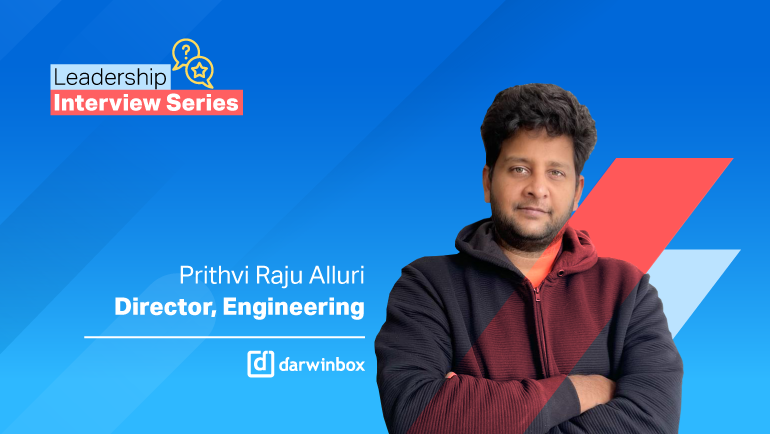

When unforeseen change occurs, it’s the agile and prepared who can ride the wave and come out on top. Darwinbox has been able to weather the storm of the pandemic successfully and grow in the process. This is in large part due to its superb technology architecture and the agility of its engineering staff.
Joining us to tell us more about how Darwinbox navigates technological turmoil and what lessons may lie in that ferment is Prithvi Raju Alluri, the Director of Engineering at Darwinbox. With more than 15+ years of experience in the infrastructure and security space, Prithvi is a trusted professional in the industry. He is a strong DevOps and Cloud Architect and has a strategic mind coupled with detailed operational expertise.
Prithvi takes pride in having worked with different organizations, from start-ups to large organizations in his career. At Darwinbox, Prithvi leads the engineering teams to make sure the systems and processes run as planned and remain secure.
Let’s learn about how organizations can thrive amid yet more change, what the best practices are for dealing with sensitive data, some of the secret sauce to Darwinbox’s legendary 100% uptime record, and of course, a little more about Prithvi himself.
Darwinbox: In the current scenario of remote and hybrid work, which aspects of technology deployments do CHROs and CIOs need to prioritize?
Prithvi: The pandemic has brought about far-reaching changes in the way we use and deploy technology, highlighting the absolute need for a cloud ecosystem. In the context of hybrid work, the complexity of the requirement intensifies.
For example, if everyone is working from the office, the way you need to ensure bandwidth capacity is different, but if most or some people are working from home, there is a different landscape that you need to think about because the bandwidth of the corporate network-only setup does not make sense anymore. The job of CHROs and CIOs is to figure out how you prioritize traffic between the different assets that you have.
Added to that are the security and compliance angle – protecting corporate assets and customer data is more difficult now because almost all employees or assets are situated outside the corporate network, which is ungoverned. Therefore, the threat landscape or the cyber threat landscape has increased, which forces technology administrators to work on a zero-trust basis, which means do not trust anything, even if the device or a person has an authenticated asset or authenticated laptop or is an authenticated user. In the world of hybrid work, there are sound reasons to deploy a zero-trust network.
The other critical aspect has become the mobile-first approach while taking into consideration the security aspect of access to data, etc. through mobile devices, something we at Darwinbox prioritize.
All this applies to the HCM tool you are looking for, especially a cloud-based SaaS one. The tool that you choose needs to enable you to configure and customize based on your corporate rules and policies. The platform should enable you to configure based on your policies rather than redefining your policies.
Darwinbox: What’s been your experience of data localization and what are the best practices you would recommend?
Prithvi: Each region and growing number of countries are creating their own data localization rules. Therefore, the way we build systems needs to be carefully looked at. How do we solve for this? At Darwinbox we solved it with DevOps.
For example, we recently onboarded a customer who wanted a data center in a specific country in Europe, which we were able to provide. Because our choice of platform deployment is scripted with configurable variables like region, stack, modules, etc. we can launch a new data center for a customer or to satisfy government policy at the click on a button. That is one way of solving for it.
The other way of solving for it is: How do we classify the data? Because certain data is not personally identifiable information (PII) and transactional data does not need data localization, how do we deal with that? We classify PII data, we store it, and we deal with it in a separate way. We classify transactional data, and we store and deal with that in a separate way. For example, if Indonesia wants data localization on a later day, all we will need to do is pick the PII data of Indonesian employees and place it in a database in Indonesia and that is the way we can solve for both scenarios. This is a best practice I would recommend that can be followed widely.
Darwinbox: Darwinbox’s debut on the Gartner Magic Quadrant underlined its focus on technology. How has our technology been the key differentiating factor for the company’s 600+ clients?
Prithvi: Since Darwinbox was born in the cloud, the architecture for our human resource management system (HRMS) was specifically designed to take advantage of the many benefits of cloud computing (scalability, elasticity, and agility). The Darwinbox HRMS is built as a cloud-agonistic solution. As of today, the Darwinbox HRMS application is deployed on two public clouds, and customers can choose to adopt either one. We can achieve this by not choosing to deploy a cloud-native persistent stack on cloud provided managed services (like databases, storage, etc.).
Data centralization, classification, and security is built into the design from the ground up. Technologies like Dockers, Kubernetes, Istio, Spinnaker are deployed and customized to serve our business objectives. It is seamless to deploy 10 customers or 1000 customers, as the platform scales up automatically based on usage. Matured algorithms are implemented to ensure a wonderful experience for our customers. The Darwinbox platform’s uptime report of 100% between 2017 and today is a testimony to our choice of technologies and product development methodologies.
Darwinbox: What are the key strategies and principles underlying Darwinbox’s current technology stack and approach?
Prithvi: Practicality and wise frugality have been our watchwords. We did not buy hundreds of servers. Instead, we subscribed to cloud technologies on their pay-as-you-go model, which means for 1000 customers, we pay only for those customers, no more. As we grow, we can increase the tech stack. Since we were born in the cloud, the architecture that we have designed and deployed can serve 50 customers just as well as 50,000 customers.
There is no human intervention needed to scale up the systems. As customers increase, the scale increases automatically, based on usage. This is something that is evolving, something we have been improving over the last five years. Everything is baked into a DevOps process which ensures that the system is always available and only a qualified and signed-off code is promoted to production.
The other focus for us has been the microservices approach. For example, let us assume that there is this feature requirement for payroll. We need not wait for the whole product development process to be completed to release it. We can build it in a day and release just that feature. The same applies to bug fixes. The same applies to any production issues or performance issues, and we can independently deploy modules and run them separately, which makes it easy to scale and scale better. This is the advantage of microservices and speaks to the agility of our product roadmap.
Darwinbox: "Eat, code, repeat"— tell us about your mantra.
Prithvi: If we look back at the past 2 decades, we have distinct phases in the way tech and technologies are evolving. Fortunately, I have been part of every phase of this evolution, working with teams to launch web applications in 10 weeks to 10 hours.
I’m an engineer and like every other engineer, problem-solving is something that motivates me. If I am to give advice to someone who would like to innovate or participate in building something, I recommend they get their hands dirty – if you can’t code, you can’t build the future.
At Darwinbox, engineers are solving business problems with passion. There is always something new to explore within the team that is being built. There is no better place for any engineer to be than contributing to the Engineering team at Darwinbox.
Thanks for all the insights, Prithvi! And for all the engineers reading – interested in joining the Engineering team at Darwinbox? Head over to our Careers page today and apply!



Speak Your Mind